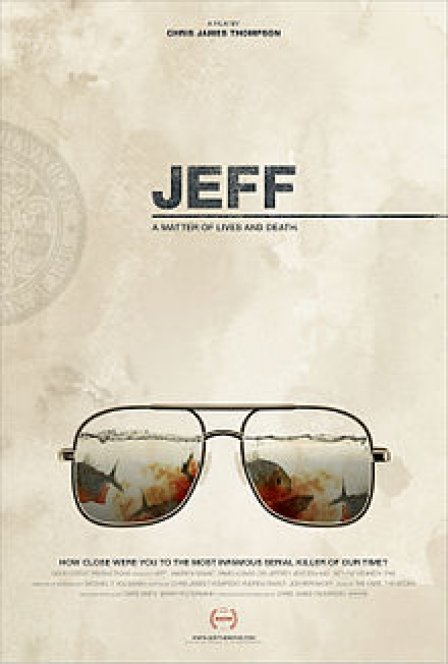1. Jeff is a documentary about Jeffrey Dahmer. The film’s main focus is on three people who knew Dahmer: the medical examiner, the detective assigned to his case, and a neighbor who lived in his building. There are reenactments.
2. The reenactments include Dahmer going to the store to buy beer; Dahmer going to the store to buy giant blue barrels; Dahmer riding the bus; Dahmer buying goldfish in a pet store; Dahmer drinking beer at the state fair; Dahmer getting a hotel room with a man.
3. Andrew Swant, the actor who plays Jeffrey Dahmer, is a filmmaker from Wisconsin who created the viral video, “What What (In the Butt).” According to Wikipedia: “‘What What (In the Butt)’ is a viral video created by Andrew Swant and Bobby Ciraldo for the song of the same name by Samwell. It is known for its numerous camp references to homosexuality and anal sex. The lyrics of the song, a production of Mike Stasny, mostly revolve around the title. The video was uploaded on Valentine’s Day 2007 to YouTube and as of September 2012, it had over 48.5 million views.”
4. Reenactments are inherently eerie, but these seem even more so. The reenactments are shot in Super 16mm, and their low-rent, amateurish quality lends a television kitsch to the film’s subject. Swant acts as though his friends wanted to make a low-budget film about a white dude getting drunk and walking around town. The dialogue is clunky and everyone is probably a little tanked. I think I really liked it. Seems like most people will not like it. Seems like people will want Swant to do something crazy like Charlize Theron in Monster, when she gained all that weight and shaved her eyebrows. But Swant plays Dahmer as a bro who wears jeans and buys beer everyday. The artifice of the reenactment is heightened when it is acknowledged. I hope the decision to go about fictionalizing Dahmer’s day-to-day life was as intentional as it seems, otherwise, it loses the genius. Or maybe not.
5. Fuck Errol Morris.
6. People are fascinated with serial killers because of the ways in which they demonstrate our worst capabilities. A difference in brain pattering, in upbringing, in ‘morality’ — these are just a few of the paper-thin reasons why they act and we don’t. When the detective remembers Dahmer’s reasoning behind drilling holes in people’s heads, in the effort to create “the ultimate zombie, or sex slave,” he says Dahmer wanted someone around to love and to fuck without the hassle of conversation. This is marriage, relationships, loneliness, the desire to love without the ruin of language. We can understand, and that is what frightens.
7. Dahmer lived in a poor black neighborhood. What I know of the Dahmer case may be limited, but this is the first film I’ve seen to highlight this aspect, albeit very briefly. A percentage of Dahmer’s victims were gay black men, and this racial component is important, as is his neighbor, Pamela Bass’ experience living in the same building as Dahmer. She says he was a nice man, sometimes they ate sandwiches together, and he stood out for being white. She gets emotional and says perhaps things could have been different had the city of Milwaukee embraced, rather than neglected, their black neighbors.
8. Pat Kennedy, the homicide detective and interrogator assigned to the case, gives the filmmakers an incredible interview. His expressions, his moustache, his accent, are a just a few of the characteristics that make him a theatricality alongside Dahmer. He tells us about sitting in the interrogation room with Dahmer for hours, discussing God, alcoholism, Martin Luther, death, etc. Kennedy formed a unique relationship with Dahmer, and felt personally affected by the trial, by Dahmer’s homosexuality and shame, as his marriage had just fallen apart due to his infidelity. The blue-striped shirt worn by Dahmer to trial belonged to Kennedy’s teenage son. Kennedy talks about how difficult it was to hear Dahmer’s sentence, even though what Dahmer had done was what Dahmer had done. He talks about what life was like after the sentencing, without the interrogation room conversations, and without this bizarre relationship he had formed with a serial killer. Kennedy’s eyes are big and sad, and his voice echoes throughout the abandoned theater where he’s being interviewed. I felt overwhelmed by him. His moments are what make the film worth watching, not Dahmer.
9. The film ends with footage of the demolition of the apartment building where Dahmer and Pamela Bass lived. The song, “Still Light,” by The Knife, is playing. Is this tacky? Maybe. But for such a bloodless, quiet, slowly-paced film about one of America’s most notorious serial killers, it seems oddly appropriate.

